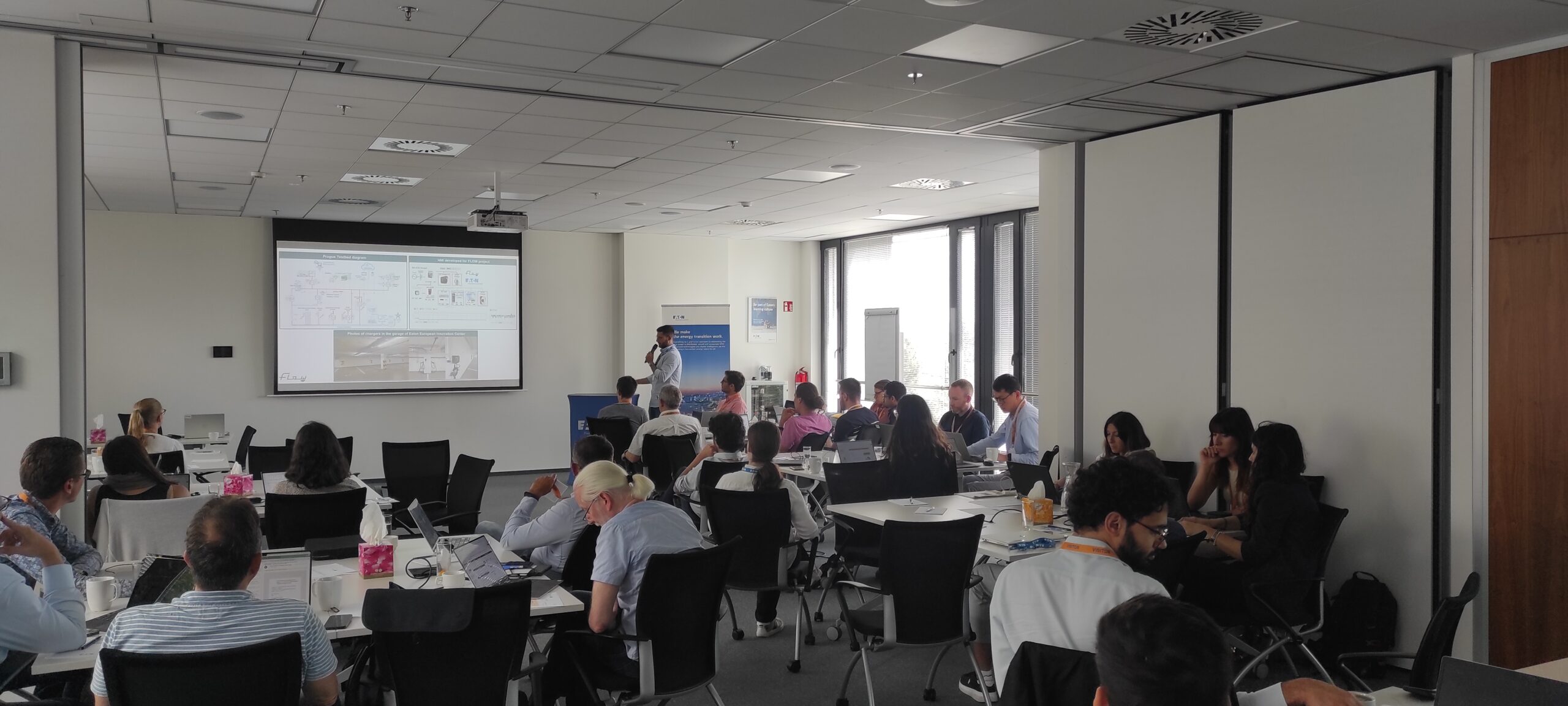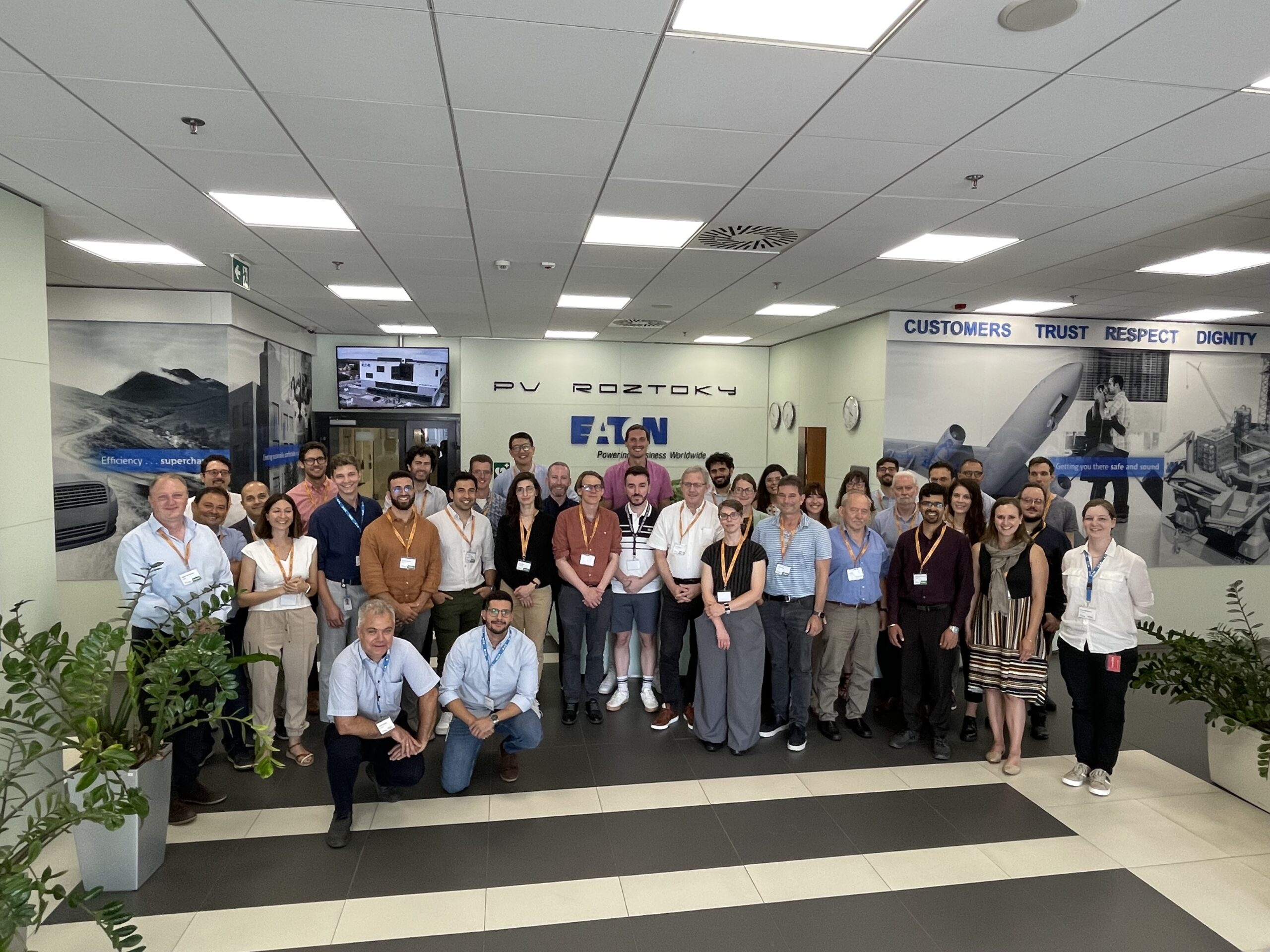Navigating the EV revolution: unlocking opportunities and overcoming challenges of V2G

Drawing insights from a recent workshop held on July 11th by the FLOW project consortium, hosted by EATON CZ and led by R2M Solution, this event brought together a diverse range of stakeholders. Grid operators, top-tier professionals in the electricity market, technical researchers, social scientists, and technical consultants gathered to discuss key challenges and opportunities shaping the future of sustainable mobility. Experts from diverse fields—including electricity market professionals, technical researchers, social scientists, policy and regulatory experts, and industry specialists—gathered to explore the challenges and opportunities shaping the future of sustainable mobility; key players such as Transmission and Distribution System Operators (TSOs and DSOs), aggregators, Charging Point Operators (CPOs), and grid commercial stakeholders contributed a broad spectrum of expertise and perspectives, grounding the discussion in real-world challenges and opportunities, ensuring relevancy to the operational realities of the energy market.
Insights from the Workshop
The workshop highlighted the diverse perspectives of stakeholders, providing a rich understanding of the opportunities and challenges in the EV ecosystem. The following sections will explore the perspectives and roles of these key stakeholders in the EV ecosystem, addressing both opportunities and challenges. We will examine the unique insights from EV users, commercial actors, aggregators, TSOs, DSOs, CPOs, and policymakers, shedding light on how each group can contribute to the successful deployment of V2G technology and the broader electrification of transport.

1. EV Users:
Social scientists, researchers, and commercial actors synthesised the findings of surveys and their collective expertise to discuss the key opportunities presented by the penetration of EVs and V2G for EV users.
Opportunities: The workshop highlighted that EV users can match their needs and motivations with the inherent attractiveness of EV technology and their smart operations. Financial concerns are a major driver for EV users, with electricity bill savings emerging as a key motivator. Additionally, the rising awareness of carbon footprints (individual perspective) and the carbon budget for future generations (systemic perspective) has emerged as a significant factor. Finally, the inevitable rise of EVs presents a clear opportunity to leverage an existing and available technology, maximising its use in sustainable mobility efforts.
Overall, smart operations of EVs through V2G align with user needs, enhance financial and environmental benefits, positioning EVs as one of the key components of future mobility solutions.
Threats: However, EV users face notable barriers such as concerns around smart charging, interoperability challenges, and data privacy. The fear that smart charging may interfere with users' control over their vehicle’s energy use or increase charging costs adds to the hesitation. Moreover, the lack of standardised charging technologies can result in compatibility issues between different systems, while privacy concerns arise due to the vast amounts of data exchanged during smart charging sessions. Addressing these challenges, increasing V2G public understanding and standardisation, will be essential to boost adoption.
2. Commercial Actors:
Opportunities: Commercial actors in the EV sector, such as electricity retailers, e-mobility services providers and charging station manufacturers, have significant opportunities to profit from dynamic tariffs (in particular in Italy), grid services, and data-driven innovations. The growing EV market opens the door to new business models related to V2G energy management and enhanced user services. One of the foremost opportunities lies in the diffusion of dynamic tariffs, particularly in Italy, where such tariffs can encourage EV users to charge during off-peak hours, thus reducing costs and optimising grid performance. Similarly, the promotion of tailored grid services across the EU offers a pathway for commercial actors to engage with utilities and contribute to a more resilient energy infrastructure, creating additional revenue streams. Data-based services offer a significant opportunity in the EU, allowing companies to utilise customer data and vehicle performance metrics to deliver personalised solutions that enhance user experience and satisfaction. This data-driven strategy helps commercial actors understand consumer behaviour, leading to tailored offerings that boost customer loyalty.
Additionally, conditional connection agreements enable customers to pay less by using only the nominal power they need, reducing costs and promoting more efficient resource use within the energy system.
Threats: commercial players must navigate a landscape with obstacles and barriers such as regulatory hurdles, a lack of industry standards, technology interoperability challenges and a lack of trust regarding the availability of distribution assets from TSOs and DSOs. These constraints hinder the ability to deploy solutions at scale and capture market value. Specifically, the variability of regulations across regions creates uncertainty, while the lack of standardisation can lead to increased costs. Companies may need to invest in multiple solutions to accommodate different systems, further complicating their efforts. It also creates fragmentation in the market, discouraging investment and complicating the integration of new services. Companies that can successfully address these threats by advocating and advancing technology standardisation will be well-positioned to unlock the full potential of EV integration and capture value. Finally, building confidence among stakeholders (especially with TSOs and DSOs) will be essential to fostering collaboration and ensuring a reliable infrastructure for EV integration.
3. Aggregators:
Aggregators, including flexibility market participants, demand response operators, virtual power plant (VPP) operators, and local-level aggregators such as energy community managers, are well-positioned to capitalise on emerging opportunities of the evolving EV ecosystem.
Opportunities: One significant opportunity lies in creating value along the value chain. By effectively managing distributed resources, aggregators can generate revenue for both ends of the value chain, TSO/DSO on one side, and asset managers/owners on the other. This collaboration not only enhances grid stability but also increases revenue opportunities for asset owners. Another key aspect is the expansion of controllable assets. As demand for energy flexibility grows, aggregators can broaden their services by incorporating diverse resources, such as battery storage systems and demand response capabilities. This enables them to cater to a wider range of customers and enhance market presence. Fluctuating spot prices also create additional opportunities for asset owners. By participating in the flexibility market, those with local generation capabilities can unlock further revenue potential, capitalising on market dynamics while maintaining autonomy. Overall, aggregators contribute to user satisfaction by providing financial incentives and operational support to asset owners, while generating income for TSOs and DSOs through efficient asset management.
Threats: One major threat is the risk of grid overload, which can arise from insufficient coordination between DSOs and TSOs. As local power generation increases, aggregators face a significant challenge in gaining user acceptance: Many users are hesitant to relinquish control over their assets, often questioning the need for aggregators to manage them.. Additionally, many installed assets may have slow response times, making it difficult for aggregators to deliver the required services effectively. This highlights the necessity for aggregators to thoroughly validate the assets they enrol. The lack of reliable data exchange and management also presents an obstacle, again highlighting the need for coordination among TSOs, DSOs, and aggregators. In summary, aggregators must address these interconnected threats by fostering collaboration, improving asset responsiveness, and ensuring effective data management to succeed in the evolving EV ecosystem.
4. TSO, DSO and CPOs
4.1. TSO Opportunities and Challenges
Opportunities: For TSOs, integrating EVs presents significant opportunities to enhance grid management. They can utilise frequency restoration services to stabilise the grid and respond quickly to fluctuations. By leveraging both manual (mFRR) and automatic (aFRR) frequency restoration reserves, TSOs can employ EVs as distributed energy resources (DERs). Furthermore, promoting load shifting through EV charging helps optimise energy flow, reducing stress on the grid during peak demand.
Threats: However, significant challenges remain. A lack of standardised technologies and interoperability complicates the scaling of these services across different regions and systems. Additionally, the mismatch between current technological capabilities and grid service requirements limits the practical application of EV integration. Furthermore, the limited aggregation of EV resources hampers the establishment of commercially viable business models, impeding market development.
4.2. DSO Potential and Barriers
Opportunities: For DSOs, EVs offer potential to improve grid efficiency and defer costly infrastructure upgrades. Implicit flexibility, where users voluntarily shift demand, and explicit flexibility through V2G services enable better energy management. By leveraging smart charging and V2G, DSOs can optimise load capacity without expanding their networks, which is crucial as EV adoption increases. Significant cost savings can be achieved by reducing the need for grid reinforcement.
Threats: Nonetheless, these opportunities come with considerable threats. Coordination with TSOs is essential to prevent grid congestion and voltage violations. Regulatory barriers and unclear market structures for flexibility services hinder widespread adoption. Additionally, the absence of standardized, interoperable technologies limits DSOs' ability to seamlessly integrate EVs into grid operations.
4.3 CPO Market Dynamics
Opportunities: CPOs stand to benefit from the expanding EV market through revenue-sharing models related to grid services such as managed charging. By partnering with DSOs and TSOs, CPOs can capture value from the services they provide, including grid support and load management. As EV adoption increases, the volume of charging sessions can offset smaller individual transaction fees with higher overall usage.
Threats: However, the rise of private home and workplace charging presents a serious threat to public charging infrastructure, potentially shrinking the market for CPOs. Interoperability issues and the complexity of managing diverse charging systems complicate operations, making it challenging to maintain high-quality service. Additionally, as data volumes grow with the expansion of the EV market, CPOs face increasing challenges in managing the data flow from charging sessions and energy transactions.
5. EV Charging Infrastructure Planners, Policymakers, and Market Regulators:
Opportunities: For central institutions, electric vehicle charging infrastructure (EVCI) planners, and regulators, the expansion of EV infrastructure presents a dual opportunity. Standardisation, coordination, and effective incentive schemes can drive significant market growth, improve user satisfaction, and stabilise the grid. Creating a supportive regulatory framework is essential to unlock the full potential of EV adoption.
Threats: Fragmented standards, regulatory uncertainty, and political changes are some of the key challenges facing EVCI planners and regulators. These threats complicate efforts to create unified, scalable solutions for EV infrastructure. Overcoming these barriers will require proactive planning, collaboration across sectors, and forward-thinking policy frameworks.
Conclusion
The workshop underscored the importance of collaboration across the EV ecosystem to realise the full potential of EV infrastructure and smart operations through V2G. A key takeaway is the urgent need for standardisation and harmonised regulations to overcome market fragmentation. There is a consensus that prioritising data sharing, cybersecurity, and interoperability is essential to fully capture the opportunities presented by EVs, such as improved grid stability, user satisfaction, and reduced infrastructure costs.
Moving forward, policymakers, regulators, and market participants must continue to collaborate to address these challenges, ensuring a smooth transition to a fully electrified and flexible grid.

